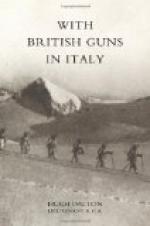During August and September we were kept pretty busy on the Plateau. Concentrations on enemy trenches and wire and special counter-battery shoots by day and counter-battery support of Infantry raids by night were continually required of us. We fired high explosive by day and chiefly gas shell at night. Our own Infantry and the French on our right raided the enemy’s front and support lines very frequently, bringing back many prisoners. The French constantly penetrated and reconnoitred the enemy’s defensive system on Mount Sisemol. Many of us were inclined to think that the casualties, sometimes heavy, which were incurred in these raids, and the great quantity of ammunition shot away, were largely wasted. We saw no sufficient return for them, beyond a certain amount of information obtained from prisoners, much of which was of small and doubtful value. But in view of what happened later, I think it must be agreed that these continual raids and bombardments did their share in gradually wearing down the morale and power of resistance of the Austrian Army.
There was a persistent rumour that the enemy was on the point of retiring to a line, on which he was known to be working hard, along the lower slopes of Monte Interrotto and Monte Catz on the far side of the Plateau. This line, we learned from prisoners, was commonly referred to as the Winterstellung (winter position). It would have been stronger, defensively, than his existing line, and would have had the great advantage of being able largely to be supplied and munitioned during daylight, as there was much good cover and roads hidden in the pine woods leading down immediately behind it. It would have involved the moral disadvantage of evacuating the ruins of Asiago. But, with the snow down on the Plateau, every Austrian track and foot-mark would have been visible from our O.P.’s, and the Austrian situation, bad as it already was from this point of view, would have become quite intolerable. If, on the other hand, we had followed up an Austrian retreat to their Winterstellung by the occupation of Asiago and the throwing forward of our line across the Plateau, the relative situation would have been reversed. Our Infantry and many of our Batteries would then be out in the open, in view from the Austrian O.P.’s, unable to light a fire by day, and only able to send up supplies by night; and our general situation would be so much the worse with heavy snow increasing our discomfort and the visibility of any work we might undertake and of our every movement.
For this reason, as has been explained in an earlier chapter, it was taken for granted that a small advance from our present excellent line would be worse than useless, and that only an advance at least to the crest of the first mountain range beyond the Plateau would be of any military value. The possibility of such an advance being attempted was evidently still in the minds of the Staff, for our forward or Battle Position at San Sisto had to be kept in constant readiness for occupation, and it was suggested by some that the occasion for a big attack would be the moment when the enemy was in the act of retiring voluntarily to his Winterstellung, necessarily a somewhat difficult and risky operation.




